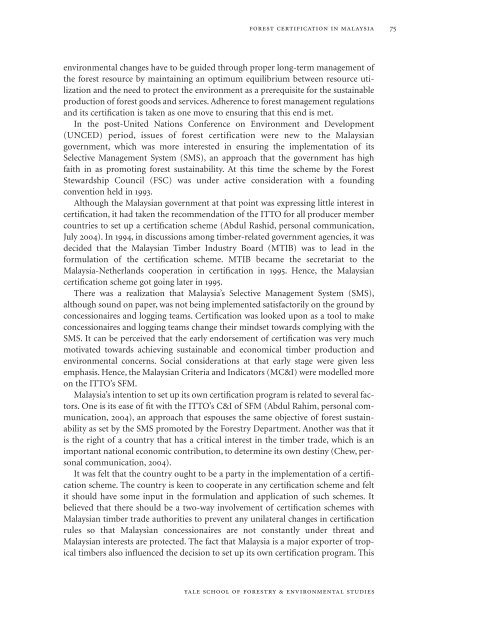Forest Certification in Malaysia - Yale University
Forest Certification in Malaysia - Yale University
Forest Certification in Malaysia - Yale University
You also want an ePaper? Increase the reach of your titles
YUMPU automatically turns print PDFs into web optimized ePapers that Google loves.
forest certification <strong>in</strong> malaysia<br />
75<br />
environmental changes have to be guided through proper long-term management of<br />
the forest resource by ma<strong>in</strong>ta<strong>in</strong><strong>in</strong>g an optimum equilibrium between resource utilization<br />
and the need to protect the environment as a prerequisite for the susta<strong>in</strong>able<br />
production of forest goods and services. Adherence to forest management regulations<br />
and its certification is taken as one move to ensur<strong>in</strong>g that this end is met.<br />
In the post-United Nations Conference on Environment and Development<br />
(UNCED) period, issues of forest certification were new to the <strong>Malaysia</strong>n<br />
government, which was more <strong>in</strong>terested <strong>in</strong> ensur<strong>in</strong>g the implementation of its<br />
Selective Management System (SMS), an approach that the government has high<br />
faith <strong>in</strong> as promot<strong>in</strong>g forest susta<strong>in</strong>ability. At this time the scheme by the <strong>Forest</strong><br />
Stewardship Council (FSC) was under active consideration with a found<strong>in</strong>g<br />
convention held <strong>in</strong> 1993.<br />
Although the <strong>Malaysia</strong>n government at that po<strong>in</strong>t was express<strong>in</strong>g little <strong>in</strong>terest <strong>in</strong><br />
certification, it had taken the recommendation of the ITTO for all producer member<br />
countries to set up a certification scheme (Abdul Rashid, personal communication,<br />
July 2004). In 1994, <strong>in</strong> discussions among timber-related government agencies, it was<br />
decided that the <strong>Malaysia</strong>n Timber Industry Board (MTIB) was to lead <strong>in</strong> the<br />
formulation of the certification scheme. MTIB became the secretariat to the<br />
<strong>Malaysia</strong>-Netherlands cooperation <strong>in</strong> certification <strong>in</strong> 1995. Hence, the <strong>Malaysia</strong>n<br />
certification scheme got go<strong>in</strong>g later <strong>in</strong> 1995.<br />
There was a realization that <strong>Malaysia</strong>’s Selective Management System (SMS),<br />
although sound on paper, was not be<strong>in</strong>g implemented satisfactorily on the ground by<br />
concessionaires and logg<strong>in</strong>g teams. <strong>Certification</strong> was looked upon as a tool to make<br />
concessionaires and logg<strong>in</strong>g teams change their m<strong>in</strong>dset towards comply<strong>in</strong>g with the<br />
SMS. It can be perceived that the early endorsement of certification was very much<br />
motivated towards achiev<strong>in</strong>g susta<strong>in</strong>able and economical timber production and<br />
environmental concerns. Social considerations at that early stage were given less<br />
emphasis. Hence, the <strong>Malaysia</strong>n Criteria and Indicators (MC&I) were modelled more<br />
on the ITTO’s SFM.<br />
<strong>Malaysia</strong>’s <strong>in</strong>tention to set up its own certification program is related to several factors.<br />
One is its ease of fit with the ITTO’s C&I of SFM (Abdul Rahim, personal communication,<br />
2004), an approach that espouses the same objective of forest susta<strong>in</strong>ability<br />
as set by the SMS promoted by the <strong>Forest</strong>ry Department. Another was that it<br />
is the right of a country that has a critical <strong>in</strong>terest <strong>in</strong> the timber trade, which is an<br />
important national economic contribution, to determ<strong>in</strong>e its own dest<strong>in</strong>y (Chew, personal<br />
communication, 2004).<br />
It was felt that the country ought to be a party <strong>in</strong> the implementation of a certification<br />
scheme. The country is keen to cooperate <strong>in</strong> any certification scheme and felt<br />
it should have some <strong>in</strong>put <strong>in</strong> the formulation and application of such schemes. It<br />
believed that there should be a two-way <strong>in</strong>volvement of certification schemes with<br />
<strong>Malaysia</strong>n timber trade authorities to prevent any unilateral changes <strong>in</strong> certification<br />
rules so that <strong>Malaysia</strong>n concessionaires are not constantly under threat and<br />
<strong>Malaysia</strong>n <strong>in</strong>terests are protected. The fact that <strong>Malaysia</strong> is a major exporter of tropical<br />
timbers also <strong>in</strong>fluenced the decision to set up its own certification program. This<br />
yale school of forestry & environmental studies
















